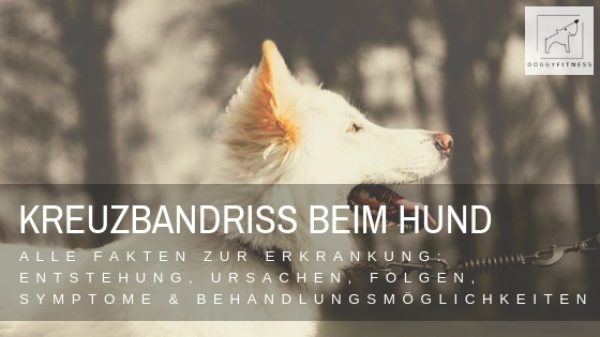Cruciate ligament rupture in dog
Cruciate ligament rupture is a common joint disease in dogs. In most cases, the anterior cruciate ligament is affected. Often a so-called “minor trauma” is enough to trigger it. This is, for example, stepping into a hole in the ground or a wrong movement during the game.
What is the structure of your dog’s knee joint?
The knee is your dog’s most complex joint. It is formed by the thigh, tibia, fibula and kneecap. In addition, it is stabilized by various components. These include muscles, the menisci, the joint capsule and the patellar ligament. There are 2 side straps that prevent lateral buckling. And then there are the cruciate ligaments, which stabilize the knee forward and backward.
How does a cruciate ligament tear occur? Which dogs are affected?
Medium to large dogs are often affected. As a rule, a genetic predisposition favors the premature and progressive wear of the cruciate ligaments. Also too much or wrong load and overweight, promote a tear. Small cracks continuously appear in the belt. At some point, one wrong movement is enough and the cruciate ligament tears. Trauma alone is rarely the sole cause. It’s just the trigger. In many dogs, the anterior cruciate ligament on the second hind leg also tears over time.
The consequences
If the cruciate ligament is partially or completely torn, the knee joint becomes unstable. Osteoarthritis develops. This also affects the menisci. Inflammation develops and the joint capsule swells. This is a reaction of the body. It ensures that the knee joint regains more stability. Massive lameness promotes tension in overstressed areas such as the back muscles.
What are the symptoms?
The cruciate ligament tear usually shows a very typical symptomatology. In the first 1-3 days after the trauma, the dog is very lame. Many dogs often run only three-legged. The knee is swollen and heated. Then the situation seems to improve again. The lameness becomes less. Often dog owners then think that their dog has only represented itself. When the dog loads more intensively again, the lameness worsens massively. Often the dogs will only step with the tip of their toes or not use the leg at all.
What other signs are there?
The dog is in severe pain and stretching and bending the knee is therefore almost impossible. In addition, he is very sensitive to touch on the knee. When the quadruped sits down, it angles the leg stretched to the side and sits down at an angle. This is because he can hardly bend the knee when it is torn or ruptured. The reason for this is the swelling in the joint and the pain.
How is the cruciate ligament rupture diagnosed?
The very typical symptoms often already give clear indications whether a cruciate ligament tear is present in your dog. To confirm the diagnosis, the veterinarian applies the drawer test and/or the tibial compression test. The “seat test” can also provide information on whether a cruciate ligament tear may be present. A lateral x-ray can also be used to determine if arthritis has developed. Also to what extent there have been changes in the knee joint that indicate a tear.
What are the treatment options?
There are several options for treatment. First, there are surgical procedures, such as TPLO, TTA, capsular tightening, and natural or artificial ligament replacement. Depending on the procedure, they vary in invasiveness and in some cases alter the biomechanics of the joint.
If you want to avoid surgery
Conservative treatment, in consultation with the veterinarian, may be appropriate. Anti-inflammatory and analgesic drugs are given. Especially in dogs up to 15 kg and also in older dogs, conservative therapy can and should be tried. Conservative treatment is also increasingly used for dogs that are not athletically managed. Both after surgical treatment of the cruciate ligament tear and without surgery, there is no way around physiotherapy. It is important to train the muscles and flexibility. The tensions of the overloaded muscles are released. A normal range of motion and confidence in the affected hind leg is trained. Only in this way can your dog move without discomfort and fully recover.
To help you actively support your dog, I’ll show you two effective and easy-to-implement exercises to try in my next blog article. With this you train the musculature, the mobility and the confidence in the affected hind leg.
Have fun with the training! Love greetings Tina
Dieser Beitrag ist auch verfügbar auf:
Français (French)
Deutsch (German)
Español (Spanish)















